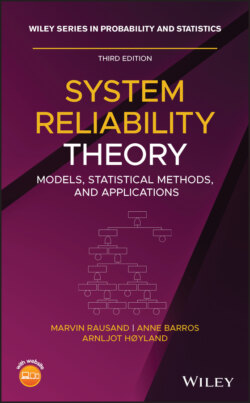Читать книгу System Reliability Theory - Marvin Rausand - Страница 60
1940s
ОглавлениеIt is often claimed that the first quantitative system reliability assessment can be attributed to Robert Lusser (1899–1969). He was a German engineer and aircraft designer who took part in several well‐known Messerschmitt and Heinkel designs during World War II. During the war, a group in Germany was working under Wernher von Braun developing the V‐1 missile, but the 10 first V‐1 missiles were all fiascos. In spite of attempts to provide high‐quality parts and careful attention to details, all the first missiles either exploded on the launching pad or landed “too soon” (in the English Channel). Robert Lusser was called in as a consultant. His task was to analyze the missile system, and he quickly derived the product probability law of series components saying that the reliability of series system is equal to the product of the reliabilities of the individual components that make up the system. If the system comprises a large number of components, the system reliability may therefore be low, even though the individual components have high reliabilities. A young mathematician, Erich Pieruschka, assisted Wernher von Braun and may have been as important as Lusser in developing Lusser's law. Some authors prefer to refer to Pieruschka's law instead of Lusser's law.
An important contribution to the subsequent reliability theory was made by the Russian mathematician Boris V. Gnedenko (1912–1995) in his 1943 paper “On the limiting distribution of the maximum term in a random series.”2 In this paper, Gnedenko provided rigorous proofs and formulated three classes of limit distributions, one of which was the Weibull distribution. Gnedenko was not the first to define the three limit distribution classes, but the first to provide proofs. The classes had earlier been defined by Fisher and Tippett (1928). The extreme value theorem proved by Gnedenko is often referred to as the Fisher–Tippett–Gnedenko theorem.
In the United States, attempts were made to compensate a low‐system reliability by improving the quality of the individual components. Better raw materials and better designs for the products were demanded. A higher system reliability was obtained, but extensive systematic analysis of the problem was probably not carried out at that time.
After World War II, the development continued throughout the world as increasingly more complicated products were produced, composed of an ever‐increasing number of components (e.g. television sets and electronic computers). With automation, the need for complicated control and safety systems also became steadily more pressing.
Several attempts to test and quantify the reliability of electronic components began in the 1940s during World War II. The war activities clearly revealed that electron (vacuum) tubes were the most failure‐prone components in electronic systems (Denson 1998). Several groups tried to identify ways to improve the reliability of electronic systems, and it was suggested that the reliability of the components needed to be verified by testing before full‐scale production.
In 1945, Milton A. Miner formulated the important Miner's rule for fatigue failures (Miner 1945). A similar rule was suggested by the Swedish engineer Nils Arvid Palmgren (1890–1971) already in 1924 while studying the life length of roller bearings. The rule is therefore also called the Palmgren–Miner's rule and the Miner–Palmgren's rule.
In 1949, the Institute of Electrical and Electronic Engineers (IEEE) formed a professional group on quality control as part of its Institute of Radio Engineers. The group got more and more focused on reliability issues and changed name several times. In 1979, the group got its current name, IEEE Reliability Society.
The first guideline on failure modes and effects analysis (FMEA) was issued in 1949 (MIL‐P‐1629 1949). This guideline was later developed into the military standard MIL‐STD‐1629A.
